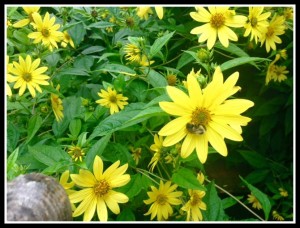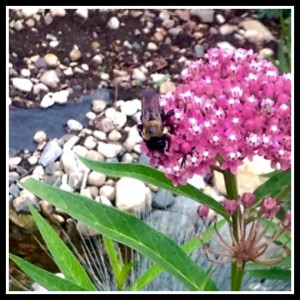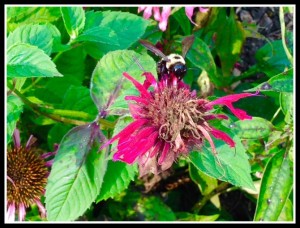The bees are in trouble. I did a quick Google search, which yielded three full pages of articles about this problem. If you read them, you’ll come away wanting to help. One way is to plant perennials that bees love.
What should you plant? This post will recommend three guaranteed winners: swamp milkweed, bee balm, and Lemon Queen perennial sunflower. These three will carry a garden from June through fall.
First on the Scene: Swamp Milkweed
The swamp milkweed (asclepias incarnarta) starts to bloom in June. It has lovely tight pink buds atop a two-to-three foot stalk. These buds open as the photo shows, and the bees come almost immediately.
Swamp milkweed offers many advantages. It is a host for the monarch butterfly caterpillar, and the plant attracts mature butterflies as well. It smells wonderful. The one drawback I have experienced with this plant is that it also attracts aphids. This is not a problem unless the plant begins to look weak. The best solution is to hose the aphids off the stems with a strong blast of water.
The Queen of Them All: Bee Balm
Bee balm (monarda Jacob Cline) reminds me of a punk rocker. It looks much better than this photo shows when it first blooms and the bees start to buzz, usually in July. By the end of bloom time, in late August, the flowers typically look tired and bedraggled. They have fed many bees, however, and so have lived a long and useful life. I have a bench near my stand of bee balm, where I can sit on a hot mid-summer day and count up to as many as 40 bees before their movements make it impossible to keep track. It’s quite an entertaining view.
These plants also offer the bonus of a wonderful minty fragrance from the time they emerge from the ground until the bees have done their work. Powdery mildew can be a problem. Thinning them early can help significantly with this.

Two original plants turned into nine that create a wall of sunflowers every fall — much to the liking of the bees.
Last but Not Least: Lemon Queen Perennial Sunflower
This vibrant yellow perennial sunflower (heliopsis Lemon Queen) is one of the stars of our fall garden. It is a hardy and prolific plant and takes well to division, as our story proves.
I originally planted two Lemon Queen sunflowers. The first year, one of them got overplanted by accident and did not do well. The following year, however, it overcame its initial setback and bloomed just as much as its fellow plant. Soon, both plants had overrun their place. My husband dug them up — no easy task, as the crown had spread to be two feet wide. He chopped the two root balls into nine pieces, which we planted along a fence. Now, each fall, we have a veritable wall of these cheerful plants. They bloom for six to eight weeks, and the bees love them.
The plants are quite tall in my garden, growing up to eight feet. They can be floppy at the end of their season because of their height, especially after a strong rainstorm. To solve this problem, simply cut them back by half their height in mid-June. They will bloom just a little bit later but just as prolifically — and they will be shorter, sturdier plants.
2015 Goals for Pleasing the Bees
As I write this post, it is mid-April. I’ve seen a few bees already in Serendipity Gardens, where the takings are slimmer than I’d like for them to be. My goal for 2015 is to plant more spring-blooming plants that the bees like. These will include more crocus, hellebore, and snowdrops.
Another goal is to simply keep in mind the plight of the bees as I make decisions for what to plant, either in beds or containers.
Related Stories
Register Your Garden as a Wildlife Habitat
Six Cheap, Easy Things You Can Do to Help the Bees — Including How to Build a Bee Hotel
Recommended Book
 Keeping the Bees by Laurence Packer is one of the best book about bees you will ever read. It will help you understand why the bees are in trouble, and will provide easy and often surprising things you can do to help, such as leaving the ground bare here and there for the bees that like to nest underground.
Keeping the Bees by Laurence Packer is one of the best book about bees you will ever read. It will help you understand why the bees are in trouble, and will provide easy and often surprising things you can do to help, such as leaving the ground bare here and there for the bees that like to nest underground.
Like this post? Sign up to receive an email each time a new post is available. We will never loan, sell or rent your email address — that’s a promise! Please use the buttons below to share with others.

